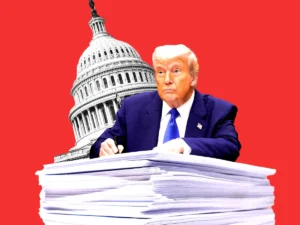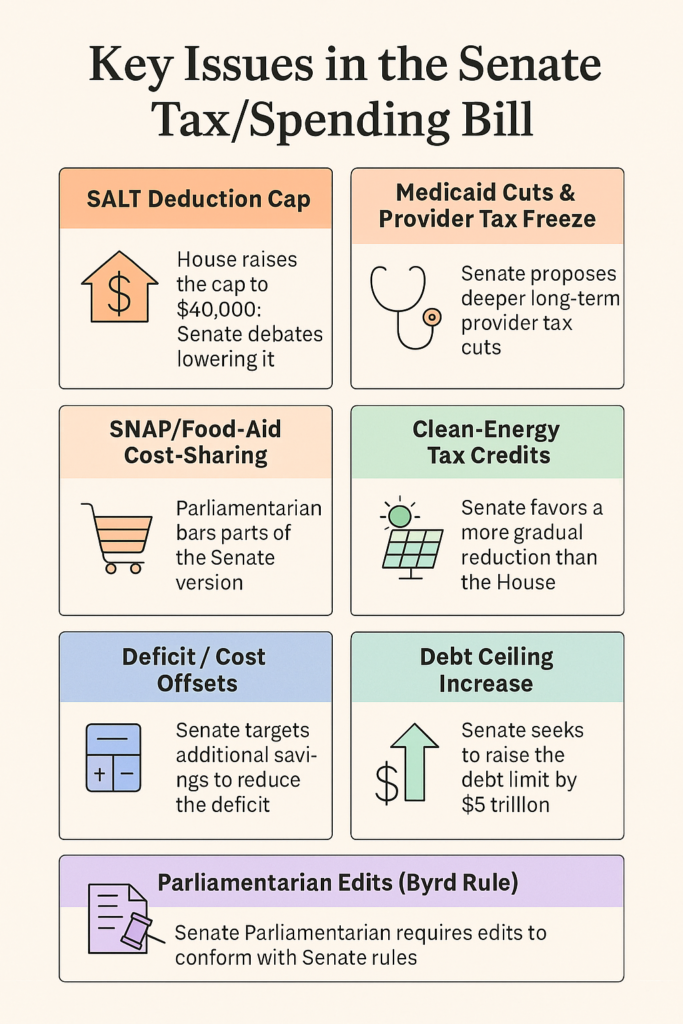Trump’s “Big Beautiful Bill”: Where Things Stand

Congress is in a race to finalize Trump’s Big Beautiful Bill and send it to his desk for signature before the July 4th recess.
Many of the bill’s provisions reflect a continuation or revival of 2017 Trump-era tax policies, with an emphasis on business investment, small business relief, and limiting government expansion. Bonus depreciation, full R&D cost expensing, and looser loan interest deductions for business are all key elements that will be in the final bill. Beyond this, new provisions such as tax breaks for seniors, are also to be expected. However, negotiations continue on other hot-button items.
As the deadline looms mere days away, let’s take a look at the issues remaining that divide the House and Senate, and point to probable outcomes in each scenario.
OVERVIEW OF KEY ISSUES

WHERE THE HOUSE AND SENATE STAND
Here’s a more detailed table of the key issues where the Senate version of the bill differs from the House‑passed version, and the likely outcomes as Senate negotiators work toward compromise:

DRILL DOWN ON THE ISSUES
Let’s dig a bit deeper into each of the above issues to better understand what they’re all about.
1. SALT Deduction Cap
- What it is: The State and Local Tax (SALT) deduction lets taxpayers deduct taxes paid to their state or local governments from their federal taxes. The 2017 tax law capped this deduction at $10,000, which especially impacted residents of high-tax states like California, New York, and New Jersey.
- What’s changing: The House raised the cap to $40,000, but the Senate is debating reducing it again or using a placeholder. Lawmakers from high-tax states want it kept high, while fiscal conservatives argue it benefits wealthier filers.
- Why it matters: It directly affects the after-tax income of higher earners in certain states and is a politically sensitive issue.
2. Medicaid Cuts & Provider Tax Freeze
- What it is: States often tax healthcare providers (like hospitals) and use those funds to increase the amount of their Medicaid funding, often seen as a loophole to boost Federal subsidy. Federal funding typically matches state funding on Medicaid. Freezing or cutting these provider taxes will impact states’ Medicaid funding, as well as the reciprocal Federal funding.
- What’s changing: The Senate version proposes more aggressive long-term reductions in the allowable provider tax rate and may expand work requirements for Medicaid recipients.
- Why it matters: These changes could lead to reduced federal Medicaid funding in some states and tighter eligibility requirements.
3. SNAP/Food-Aid Cost Sharing
- What it is: The Supplemental Nutrition Assistance Program (SNAP) is a federal food-aid program. The House bill proposed shifting more administrative and error-rate costs to the states.
- What’s changing: The Senate included similar provisions, but the Senate Parliamentarian ruled some of them violated budget reconciliation rules (the “Byrd Rule”).
- Why it matters: These provisions could reduce SNAP spending, but they’re procedurally difficult to keep in the bill.
4. Clean-Energy Tax Credits
- What it is: The Inflation Reduction Act (IRA) introduced tax incentives to promote renewable energy, EVs, and clean manufacturing.
- What’s changing: The House bill aimed to quickly repeal or scale back many of these credits. The Senate is more divided—some senators want a slower phaseout or to retain some of the credits.
- Why it matters: It impacts the future of clean energy policy, emissions goals, and industries relying on federal support.
5. Deficit / Cost Offsets
- What it is: This refers to how the bill’s spending or tax cuts are “paid for” so as not to add to the national debt.
- What’s changing: The House plan targeted $1.5 trillion in cuts. The Senate is pushing for more tax incentives while still promising to reduce the deficit—likely using budget tricks (e.g., “sunsetting” tax cuts after a few years) to make the math work.
- Why it matters: These decisions shape long-term fiscal health and influence how seriously markets and ratings agencies take deficit reduction claims.
6. Debt Ceiling Issue
- What it is: This is the legal limit on how much the federal government can borrow. Congress must raise it to avoid defaulting on debt.
- What’s changing: The House bill included a $4 trillion increase. The Senate is proposing $5 trillion to match higher spending and longer timeframes.
- Why it matters: It’s necessary to keep the government functioning, but the amount and timing influence political leverage in future fiscal battles.
7. Parliamentarian Edits (Byrd Rule)
- What it is: The Byrd Rule limits what can be included in reconciliation bills (which only need 51 Senate votes) to things that directly affect federal revenue or spending.
- What’s changing: The Senate Parliamentarian has ruled that certain provisions—like stripping power from regulatory agencies or imposing state-level penalties—don’t qualify.
- Why it matters: These rulings force lawmakers to remove or revise parts of the bill, sometimes cutting major political priorities.
BOTTOM LINE
The Senate is expected to soften some of the harshest House provisions (food‑aid penalties, clean‑energy rollback), maintain or deepen certain tax and Medicaid cuts (provider freeze, work mandates), and land on a SALT deduction cap near $35–40 k. Procedural housekeeping to satisfy Byrd‑Rule is also ongoing. With President Trump, Leadership, and senators sprinting toward a July 4 self‑imposed deadline, the final text will likely be a hybrid: tougher than House in areas like Medicaid, but more moderate on safety-net and energy provisions.
Perhaps most importantly, many business-friendly areas are already agreed upon between House and Senate. Assuming the bill eventually makes it past the finish line, businesses – and markets by extension – may well stand to benefit from the numerous tax breaks and incentives.
